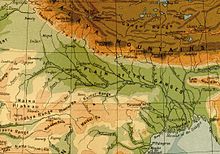Āryāvarta (Sanskrit: आर्यावर्त, lit. "Land of the Aryans",[a][web 1][web 2] Sanskrit pronunciation: [aːrjaːˈʋərtə]) is a term for the northern Indian subcontinent in the ancient Hindu texts such as Dharmashastras and Sutras, referring to the areas of the Indo-Gangetic Plain and surrounding regions settled by Indo-Aryan tribes and where Indo-Aryan religion and rituals predominated. The limits of Āryāvarta extended over time, as reflected in the various sources, as the influence of the Brahmanical ideology spread eastwards in post-Vedic times.[3][4]


Geographical boundaries
Ganges-Yamuna doab


The Baudhayana Dharmasutra (BDS) 1.1.2.10 (perhaps compiled in the 8th to 6th centuries BCE) declares that Āryāvarta is the land that lies west of Kālakavana, east of Adarsana, south of the Himalayas and north of the Vindhyas, but in BDS 1.1.2.11 Āryāvarta is confined to the doab of the Ganges-Yamuna. BDS 1.1.2.13-15 considers people from beyond this area as of mixed origin, and hence not worthy of emulation by the Aryans. Some sutras recommend expiatory acts for those who have crossed the boundaries of Aryavarta. Baudhayana Srautasutra recommends this for those who have crossed the boundaries of Aryavarta and ventured into far away places.[5]
The Vasistha Dharma Sutra (oldest sutras ca. 500–300 BCE) I.8-9 and 12-13 locates the Āryāvarta to the east of the disappearance of the Sarasvati River in the desert, to the west of the Kālakavana, to the north of the Pariyatra Mountains and the Vindhya Range and to the south of the Himalayas.[6]
Patanjali's Mahābhāṣya (mid-2nd century BCE) defines Āryāvarta like the Vashistha Dharmasutra.[citation needed] According to Bronkhost, he "situates it essentially in the Ganges plan, between the Thar desert in the west and the confluence of the rivers Ganges (Ganga) and Jumna (Yamuna) in the east."[3]
From sea to sea
The Manusmṛti (dated between 2nd cent. BCE to 3rd cent. CE) (2.22) gives the name to "the tract between the Himalaya and the Vindhya Ranges, from the Eastern Sea (Bay of Bengal) to the Western Sea (Arabian Sea)".[7][8]
The Manava Dharmasastra (ca.150-250 CE) gives aryavarta as stretching from the eastern to the western seas, reflecting the growing sphere of influence of the Brahmanical ideology.[3]
Loss of northwest India
The post-Vedic period of the Second Urbanisation saw a decline of Brahmanism.[9][10] With the growth of cities, which threatened the income and patronage of the rural Brahmins; the rise of Buddhism; and the Indian campaign of Alexander the Great (327-325 BCE), the rise of the Mauryan Empire (322-185 BCE), and the Saka invasions and rule of northwestern India (2nd c. BC - 4th c. CE), Brahmanism faced a grave threat to its existence.[11]
The decline of Brahmanism was overcome by providing new services[12] and incorporating the non-Vedic Indo-Aryan religious heritage of the eastern Ganges plain and local religious traditions, giving rise to the Hindu synthesis.[11]
Other regional designations
These texts also identify other parts of the Indian subcontinent with specific designations. The Manusmṛti mentions Brahmavarta as the region between the Sarasvati and the Drishadvati in northwest India. The text defines the area as the place where the "good" people are born, the twice-born who adhere to the Vedic dharma, in contrast to the mlecchas, who live outside the Aryan territory and Vedic traditions.[13] The precise location and size of the region has been the subject of academic uncertainty.[14] Some scholars, such as the archaeologists Bridget Allchin and Raymond Allchin, believe the term Brahmavarta to be synonymous with Aryavarta.[15]
Madhyadesa extended from the upper reaches of the Ganges and the Yamuna to the confluence of the two rivers at Prayaga, and was the region where, during the time of the Mahajanapadas, the Kuru Kingdom and Pañcāla existed. The entire region is considered sacred in the Hindu mythology as gods and heroes mentioned in the two epics, the Ramayana and Mahabharata, lived here.[16][17]
Political history
Kanyakubja or modern day Kannauj was a central city of Aryavarta and was used as capital-city from 510 CE to 1197 CE under Maukharis, Harshavardhana, Varmans, Pratiharas and Gahadavala dynasty.[18][19][20][21][22]
The Gurjara-Pratihara king in the tenth century was titled the Maharajadhiraja of Aryavarta.[23]
See also
Notes
References
Sources
- Printed sources
- Bronkhorst, Johannes (2007). Greater Magadha: Studies in the Culture of Early India. BRILL. ISBN 9789004157194.
- Bronkhorst, Johannes (2011), Buddhism in the Shadow of Brahmanism, BRILL
- Bronkhorst, Johannes (2015), "The historiography of Brahmanism", in Otto; Rau; Rupke (eds.), History and Religion:Narrating a Religious Past, Walter deGruyter
- Bronkhorst, Johannes (2016), How the Brahmains Won, BRILL
- Bronkhorst, Johannes (2017), "Brahmanism: Its place in ancient Indian society", Contributions to Indian Sociology, 51 (3): 361–369, doi:10.1177/0069966717717587, S2CID 220050987
- Michaels, Axel (2004). Hinduism. Past and present. Princeton, New Jersey: Princeton University Press.
- Samuel, Geoffrey (2010). The Origins of Yoga and Tantra. Indic Religions to the Thirteenth Century. Cambridge University Press.
- Web-sources
Further reading
- Kane, Pandurang Vaman (1962). History of Dharmaśāstra: (ancient and mediaeval religious and civil law in India). Bhandarkar Oriental Research Institute.
- Neelis, Jason (19 November 2010). Early Buddhist Transmission and Trade Networks: Mobility and Exchange Within and Beyond the Northwestern Borderlands of South Asia. BRILL. ISBN 978-90-04-18159-5.